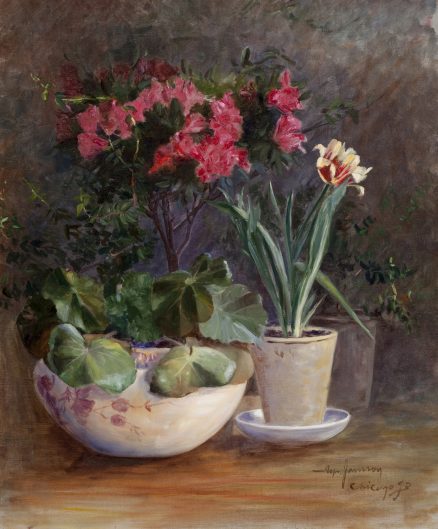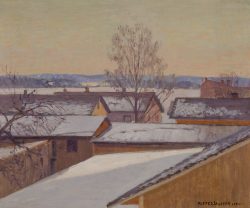- Categories
- Immigrant artists
- Still lifes
- Zoom in on Artwork
- Print Page
- Email Page to Friend
An assortment of potted plants is set on a wood surface against an undefined mottled-gray background in Alfred Jansson’s early still-life painting. The bright pink blossoms of an azalea and a potted red-and-white tulip are oriented toward muted light penetrating the scene from the upper right. The tulip’s long, slender leaves contrast with the shiny, round, slightly frilled foliage of a begonia spilling from a bowl decorated with painted flowers in dull red on a pale ground. At the left, the tendrils of an unidentified vinelike plant cling to the upright azalea; a similar plant occupies a clay pot in the shadowy background on the right. Jansson’s spontaneous, evident brushwork and the cool colors of the leaves in the foreground, especially the hints of gray in the tulip foliage and the light-blue highlights on the begonia, are the hallmarks of a “modern” style of painting in vogue in the 1890s.
This still-life composition may be the only such attributed to Jansson, who devoted his career to landscape painting. The artist took care to sign the canvas, adding “Chicago [18]93.” The flowering plants suggest he painted it in early spring—perhaps only weeks before the official opening of Chicago’s World’s Columbian Exposition in May 1893. At the fair, the Swedish Building featured two large landscape murals completed by Jansson for a commission that confirmed the young painter’s professional credibility. This modest still life, with its casual assortment of plants associated with an ordinary spring garden, seems far removed from that ambitious project. Yet in precisely noting the place and date of its creation, Jansson associated the work with an historic moment in both the life of his adopted city and his own nascent career.
Wendy Greenhouse, PhD
Donated by M. Christine Schwartz to North Park University, Chicago, Illinois, in 2021

